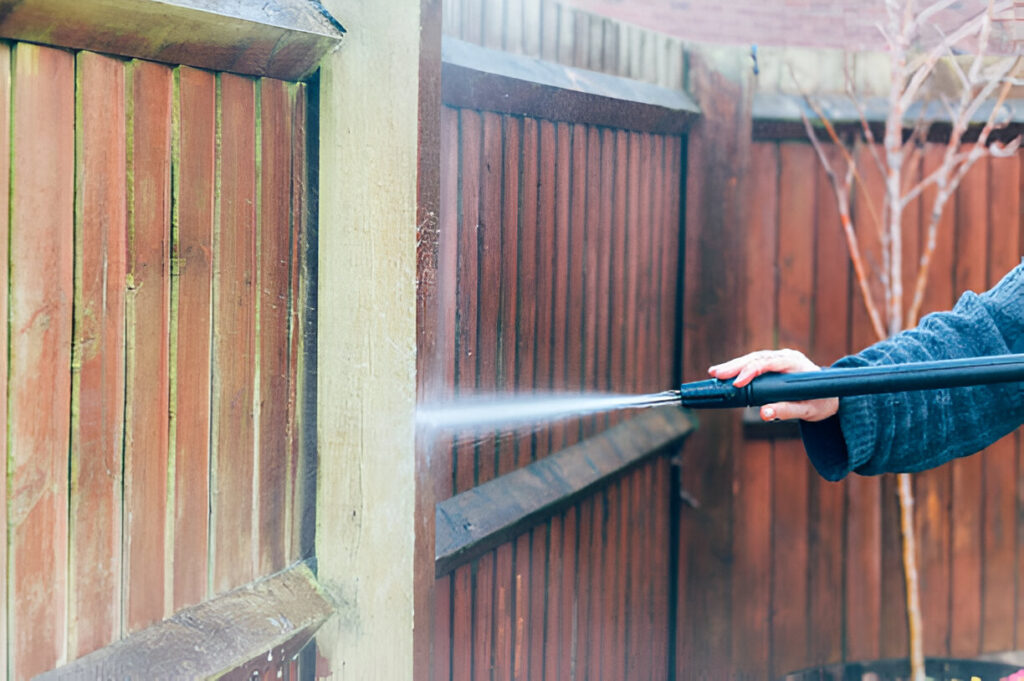
Graffiti and spray paint stains are never a welcome sight — especially when they show up on your wooden fence, deck, or siding. If you’re a homeowner or property manager facing this headache, you’re probably wondering:
Can pressure washing safely remove spray paint or graffiti from wood without ruining the surface?
The short answer is: Yes — but with caution. While pressure washing can be effective, wood is a soft material and can be easily damaged if the wrong technique is used. Let’s walk through how to safely handle graffiti removal from wood using a pressure washer. 💡🧼
🪵 Why Spray Paint Is Tricky on Wood
Spray paint penetrates the porous fibers of wood, especially if the wood is untreated or weathered. That means the paint isn’t just sitting on top — it’s absorbed into the surface.
On top of that, wood can splinter, dent, or develop gouges if blasted with too much pressure. So while pressure washing is often used on graffiti-covered concrete or brick, it needs a more delicate touch on wood surfaces.
🧼 Can Pressure Washing Remove Spray Paint from Wood?
Yes, pressure washing can lift spray paint off wood, but the results depend on:
- The type of wood (softwoods like pine are more fragile than hardwoods like oak)
- Whether the wood is treated or sealed
- How long the paint has been on the surface
- The nozzle, PSI, and distance used
Sometimes, pressure washing alone won’t remove the paint completely — but it can significantly lighten it and make it easier to finish off with a brush or chemical remover.
⚙️ How to Pressure Wash Graffiti or Spray Paint from Wood
If you’re going to tackle graffiti with a pressure washer, follow these steps:
1. Choose the Right Nozzle 🔧
Use a 40° white nozzle for a gentle spray. If you go too narrow (like a 0° red nozzle), you risk gouging the wood.
2. Set the PSI Correctly 📉
Keep the pressure between 500 and 1200 PSI.
Anything above 1500 PSI can cause serious surface damage to wood.
3. Test a Small Area First 🧪
Before blasting the entire surface, test a small, hidden patch to see how the wood reacts.
4. Use a Paint Removal Agent (Optional) 🧴
For stubborn paint, apply a wood-safe graffiti remover or citrus-based degreaser first. Let it sit for 10–15 minutes before rinsing.
5. Maintain Proper Distance 📏
Keep the nozzle at least 12–18 inches away from the surface. Move in steady, overlapping strokes.
6. Work With the Grain 🌲
Always spray in the direction of the wood grain to minimize damage.
Browse Amazon Here For Top Rated Power Washers And Accessories
❗ What NOT to Do
- ❌ Don’t use a zero-degree nozzle
- ❌ Don’t spray from an inch away — this will etch or splinter the wood
- ❌ Don’t use bleach — it can discolor and dry out the wood
- ❌ Don’t leave chemicals on too long — follow manufacturer instructions
🧰 Aftercare: Restore and Protect
Once the spray paint is removed, your wood might look uneven or weathered. Here’s how to refresh it:
- 🪵 Light sanding can smooth out any rough patches
- 🖌️ Apply a wood stain or sealer to protect it from future damage
- ☀️ Let it fully dry before using the surface again
🏁 Final Thoughts
Pressure washing is a powerful tool for cleaning graffiti off wood, but it’s not foolproof. The key is gentle pressure, the right nozzle, and good technique. If the spray paint has soaked deeply into the wood or has been there for a long time, you may need to combine pressure washing with a mild solvent or even light sanding.
With a little patience and the proper method, you can reclaim your wood surfaces and say goodbye to unwanted graffiti — all without causing harm. 👍🪵💦
Browse Amazon Here For Top Rated Power Washers And Accessories






